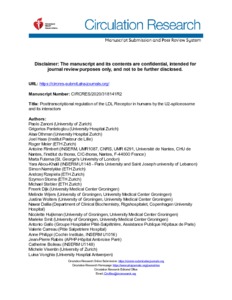Zanoni, P;
Panteloglou, G;
Othman, A;
Haas, JT;
Meier, R;
Rimbert, A;
Futema, M;
Abou-Khalil, Y;
Nørrelykke, SF;
Rzepiela, A;
et al.
Zanoni, P; Panteloglou, G; Othman, A; Haas, JT; Meier, R; Rimbert, A; Futema, M; Abou-Khalil, Y; Nørrelykke, SF; Rzepiela, A; Stoma, S; Stebler, M; Dijk, FV; Wijers, M; Wolters, JC; Dalila, N; Huijkman, N; Smit, M; Gallo, A; Carreau, V; Philippi, A; Rabès, J-P; Boileau, C; Visentin, M; Vonghia, L; Weyler, J; Francque, S; Verrijken, A; Verhaegen, A; Van Gaal, LF; van der Graaf, A; van Rosmalen, BV; Robert, J; Velagapudi, S; Yalcinkaya, M; Keel, M; Radosavljevic, S; Geier, A; Tybjærg-Hansen, A; Varret, M; Rohrer, L; Humphries, SE; Staels, B; van de Sluis, B; Kuivenhoven, JA; Von Eckardstein, A
(2022)
Posttranscriptional Regulation of the Human LDL Receptor by the U2-Spliceosome.
Circ Res, 130 (1).
pp. 80-95.
ISSN 1524-4571
https://doi.org/10.1161/CIRCRESAHA.120.318141
SGUL Authors: Futema, Marta
![[img]](https://openaccess.sgul.ac.uk/113907/1.hassmallThumbnailVersion/318141R2_Merged_PDF.pdf)  Preview |
|
PDF
Accepted Version
Available under License ["licenses_description_publisher" not defined].
Download (10MB)
| Preview
|
Abstract
Background: The low-density lipoprotein receptor (LDLR) in the liver is the major determinant of LDL-cholesterol levels in human plasma. The discovery of genes that regulate the activity of LDLR helps to identify pathomechanisms of hypercholesterolemia and novel therapeutic targets against atherosclerotic cardiovascular disease. Methods: We performed a genome-wide RNA interference screen for genes limiting the uptake of fluorescent LDL into Huh-7 hepatocarcinoma cells. Top hit genes were validated by in vitro experiments as well as analyses of datasets on gene expression and variants in human populations. Results: The knockdown of 54 genes significantly inhibited LDL uptake. Fifteen of them encode for components or interactors of the U2-spliceosome. Knocking down any one of 11 out of 15 genes resulted in the selective retention of intron 3 of LDLR. The translated LDLR fragment lacks 88% of the full length LDLR and is detectable neither in non-transfected cells nor in human plasma. The hepatic expression of the intron 3 retention transcript is increased in non-alcoholic fatty liver disease as well as after bariatric surgery. Its expression in blood cells correlates with LDL-cholesterol and age. Single nucleotide polymorphisms and three rare variants of one spliceosome gene, RBM25, are associated with LDL-cholesterol in the population and familial hypercholesterolemia, respectively. Compared to overexpression of wild type RBM25, overexpression of the three rare RBM25 mutants in Huh-7 cells led to lower LDL uptake. Conclusions: We identified a novel mechanism of post-transcriptional regulation of LDLR activity in humans and associations of genetic variants of RBM25 with LDL-cholesterol levels.
| Item Type: |
Article
|
| Additional Information: |
This is a non-final version of an article published in final form in Zanoni, P; Panteloglou, G; Othman, A; Haas, JT; Meier, R; Rimbert, A; Futema, M; Abou-Khalil, Y; Nørrelykke, SF; Rzepiela, A; et al. (2022) Posttranscriptional Regulation of the Human LDL Receptor by the U2-Spliceosome. Circ Res, 130 (1). pp. 80-95. |
| Keywords: |
1103 Clinical Sciences, 1102 Cardiorespiratory Medicine and Haematology, Cardiovascular System & Hematology |
| SGUL Research Institute / Research Centre: |
Academic Structure > Molecular and Clinical Sciences Research Institute (MCS) |
| Journal or Publication Title: |
Circ Res |
| ISSN: |
1524-4571 |
| Language: |
eng |
| Dates: |
| Date | Event |
|---|
| 7 January 2022 | Published | | 23 November 2021 | Published Online | | 19 November 2021 | Accepted |
|
| Publisher License: |
Publisher's own licence |
| Projects: |
|
| PubMed ID: |
34809444 |
 |
Go to PubMed abstract |
| URI: |
https://openaccess.sgul.ac.uk/id/eprint/113907 |
| Publisher's version: |
https://doi.org/10.1161/CIRCRESAHA.120.318141 |
Statistics
Item downloaded times since 06 Dec 2021.
Actions (login required)
 |
Edit Item |



